Nursing Care for a Patient with Huntington Disease
VerifiedAdded on 2023/01/20
|12
|1706
|34
Presentation
AI Summary
This presentation discusses the nursing care required for a patient with Huntington disease, including diet assessment and mobility evaluation. It also highlights the importance of physical and occupational therapy in improving muscle strength and flexibility. The patient's medical history and medication regimen are also discussed.
Contribute Materials
Your contribution can guide someone’s learning journey. Share your
documents today.

NURSING ASSIGNMENT
Name of the Student
Name of the University
Author note
Name of the Student
Name of the University
Author note
Secure Best Marks with AI Grader
Need help grading? Try our AI Grader for instant feedback on your assignments.
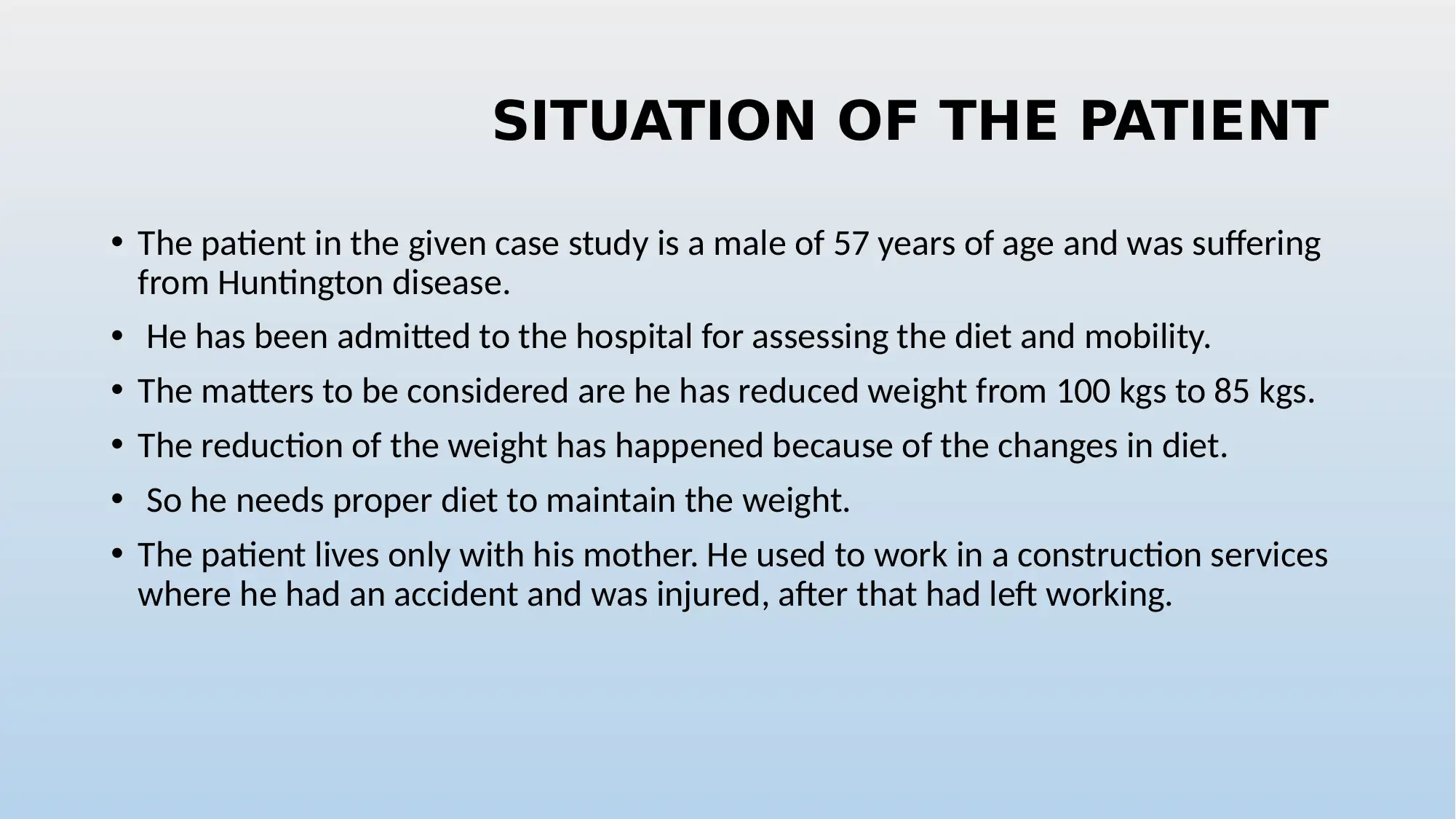
SITUATION OF THE PATIENT
• The patient in the given case study is a male of 57 years of age and was suffering
from Huntington disease.
• He has been admitted to the hospital for assessing the diet and mobility.
• The matters to be considered are he has reduced weight from 100 kgs to 85 kgs.
• The reduction of the weight has happened because of the changes in diet.
• So he needs proper diet to maintain the weight.
• The patient lives only with his mother. He used to work in a construction services
where he had an accident and was injured, after that had left working.
• The patient in the given case study is a male of 57 years of age and was suffering
from Huntington disease.
• He has been admitted to the hospital for assessing the diet and mobility.
• The matters to be considered are he has reduced weight from 100 kgs to 85 kgs.
• The reduction of the weight has happened because of the changes in diet.
• So he needs proper diet to maintain the weight.
• The patient lives only with his mother. He used to work in a construction services
where he had an accident and was injured, after that had left working.
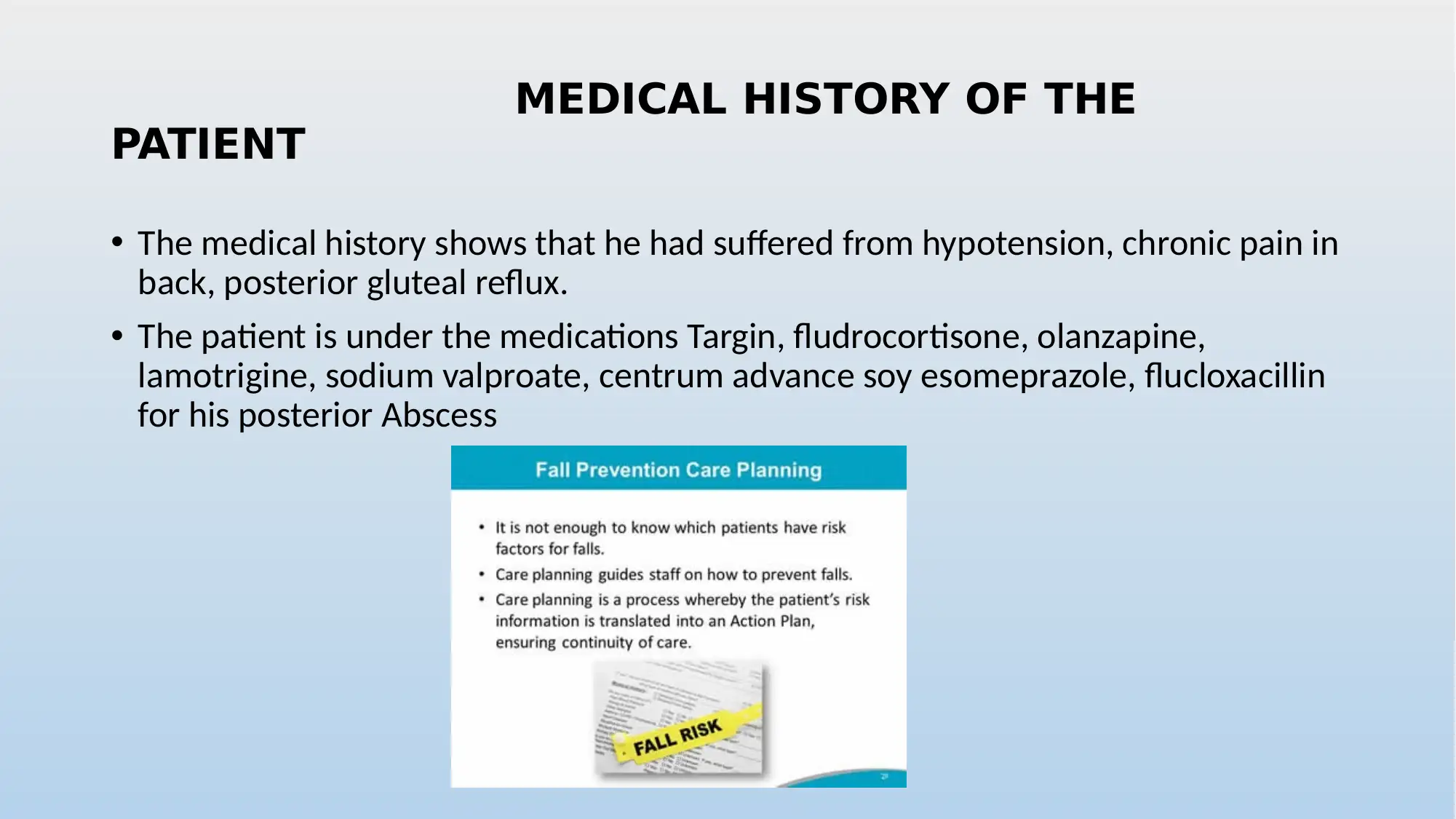
MEDICAL HISTORY OF THE
PATIENT
• The medical history shows that he had suffered from hypotension, chronic pain in
back, posterior gluteal reflux.
• The patient is under the medications Targin, fludrocortisone, olanzapine,
lamotrigine, sodium valproate, centrum advance soy esomeprazole, flucloxacillin
for his posterior Abscess
PATIENT
• The medical history shows that he had suffered from hypotension, chronic pain in
back, posterior gluteal reflux.
• The patient is under the medications Targin, fludrocortisone, olanzapine,
lamotrigine, sodium valproate, centrum advance soy esomeprazole, flucloxacillin
for his posterior Abscess
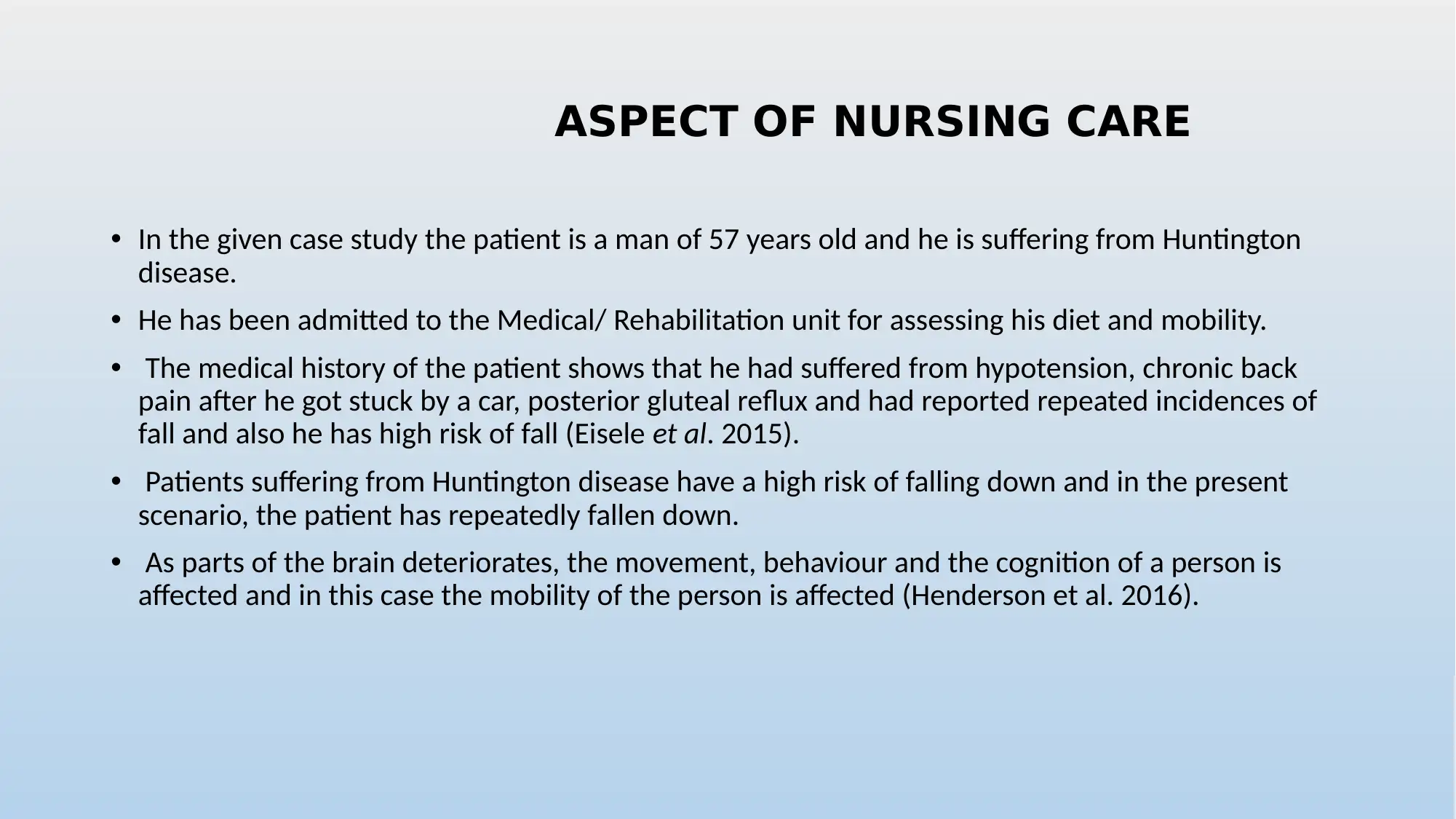
ASPECT OF NURSING CARE
• In the given case study the patient is a man of 57 years old and he is suffering from Huntington
disease.
• He has been admitted to the Medical/ Rehabilitation unit for assessing his diet and mobility.
• The medical history of the patient shows that he had suffered from hypotension, chronic back
pain after he got stuck by a car, posterior gluteal reflux and had reported repeated incidences of
fall and also he has high risk of fall (Eisele et al. 2015).
• Patients suffering from Huntington disease have a high risk of falling down and in the present
scenario, the patient has repeatedly fallen down.
• As parts of the brain deteriorates, the movement, behaviour and the cognition of a person is
affected and in this case the mobility of the person is affected (Henderson et al. 2016).
• In the given case study the patient is a man of 57 years old and he is suffering from Huntington
disease.
• He has been admitted to the Medical/ Rehabilitation unit for assessing his diet and mobility.
• The medical history of the patient shows that he had suffered from hypotension, chronic back
pain after he got stuck by a car, posterior gluteal reflux and had reported repeated incidences of
fall and also he has high risk of fall (Eisele et al. 2015).
• Patients suffering from Huntington disease have a high risk of falling down and in the present
scenario, the patient has repeatedly fallen down.
• As parts of the brain deteriorates, the movement, behaviour and the cognition of a person is
affected and in this case the mobility of the person is affected (Henderson et al. 2016).
Secure Best Marks with AI Grader
Need help grading? Try our AI Grader for instant feedback on your assignments.
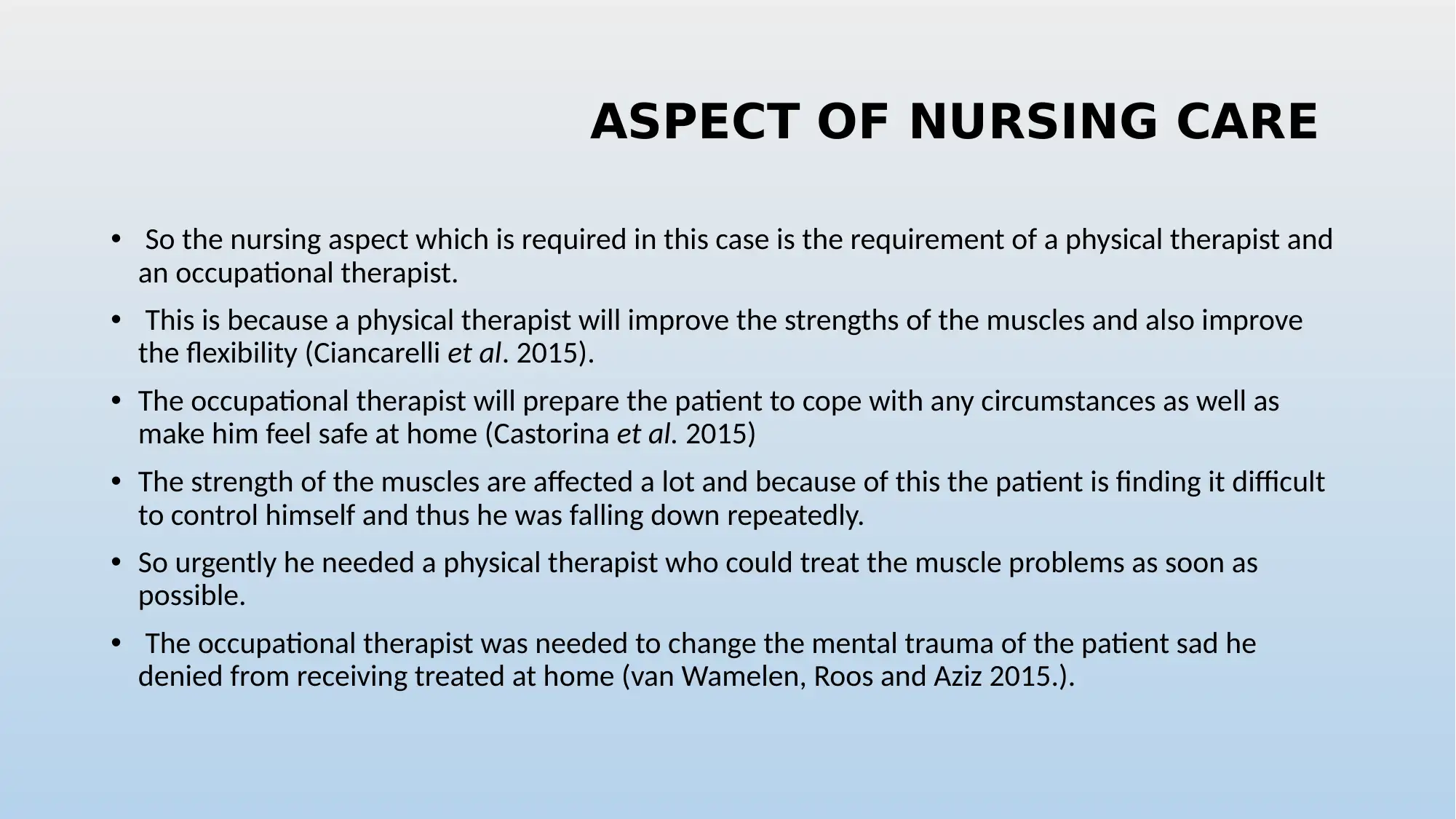
ASPECT OF NURSING CARE
• So the nursing aspect which is required in this case is the requirement of a physical therapist and
an occupational therapist.
• This is because a physical therapist will improve the strengths of the muscles and also improve
the flexibility (Ciancarelli et al. 2015).
• The occupational therapist will prepare the patient to cope with any circumstances as well as
make him feel safe at home (Castorina et al. 2015)
• The strength of the muscles are affected a lot and because of this the patient is finding it difficult
to control himself and thus he was falling down repeatedly.
• So urgently he needed a physical therapist who could treat the muscle problems as soon as
possible.
• The occupational therapist was needed to change the mental trauma of the patient sad he
denied from receiving treated at home (van Wamelen, Roos and Aziz 2015.).
• So the nursing aspect which is required in this case is the requirement of a physical therapist and
an occupational therapist.
• This is because a physical therapist will improve the strengths of the muscles and also improve
the flexibility (Ciancarelli et al. 2015).
• The occupational therapist will prepare the patient to cope with any circumstances as well as
make him feel safe at home (Castorina et al. 2015)
• The strength of the muscles are affected a lot and because of this the patient is finding it difficult
to control himself and thus he was falling down repeatedly.
• So urgently he needed a physical therapist who could treat the muscle problems as soon as
possible.
• The occupational therapist was needed to change the mental trauma of the patient sad he
denied from receiving treated at home (van Wamelen, Roos and Aziz 2015.).
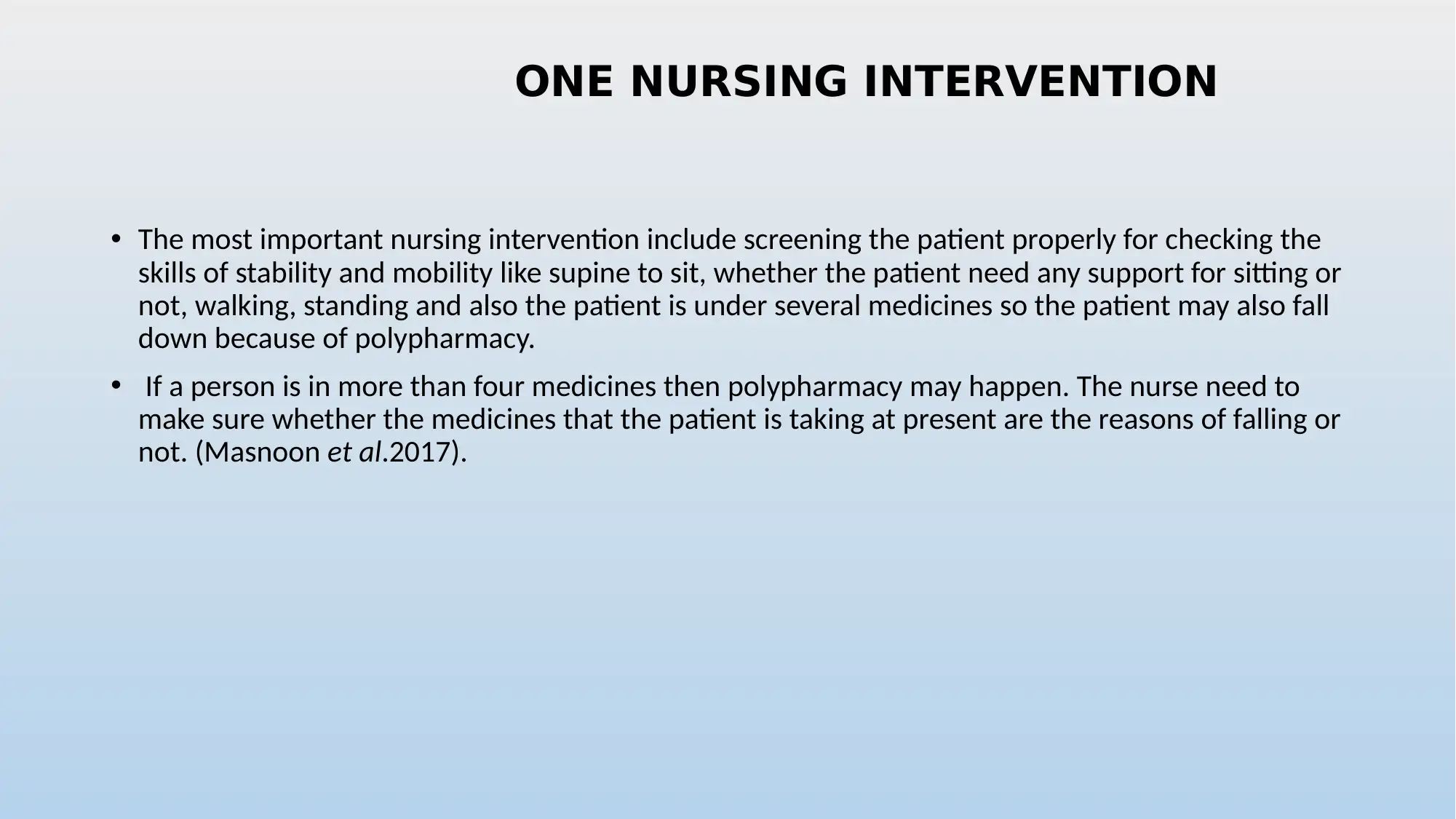
ONE NURSING INTERVENTION
• The most important nursing intervention include screening the patient properly for checking the
skills of stability and mobility like supine to sit, whether the patient need any support for sitting or
not, walking, standing and also the patient is under several medicines so the patient may also fall
down because of polypharmacy.
• If a person is in more than four medicines then polypharmacy may happen. The nurse need to
make sure whether the medicines that the patient is taking at present are the reasons of falling or
not. (Masnoon et al.2017).
• The most important nursing intervention include screening the patient properly for checking the
skills of stability and mobility like supine to sit, whether the patient need any support for sitting or
not, walking, standing and also the patient is under several medicines so the patient may also fall
down because of polypharmacy.
• If a person is in more than four medicines then polypharmacy may happen. The nurse need to
make sure whether the medicines that the patient is taking at present are the reasons of falling or
not. (Masnoon et al.2017).
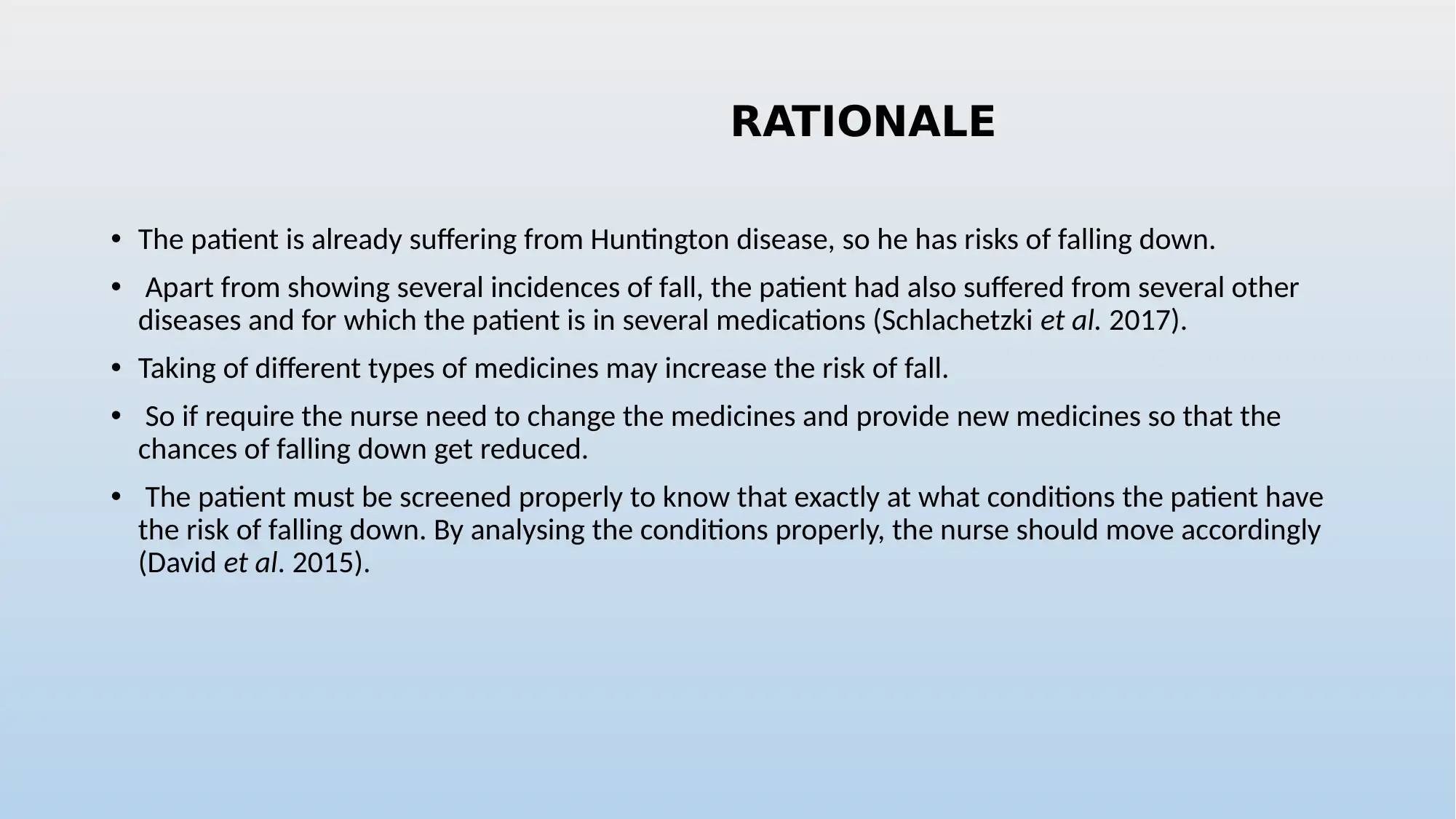
RATIONALE
• The patient is already suffering from Huntington disease, so he has risks of falling down.
• Apart from showing several incidences of fall, the patient had also suffered from several other
diseases and for which the patient is in several medications (Schlachetzki et al. 2017).
• Taking of different types of medicines may increase the risk of fall.
• So if require the nurse need to change the medicines and provide new medicines so that the
chances of falling down get reduced.
• The patient must be screened properly to know that exactly at what conditions the patient have
the risk of falling down. By analysing the conditions properly, the nurse should move accordingly
(David et al. 2015).
• The patient is already suffering from Huntington disease, so he has risks of falling down.
• Apart from showing several incidences of fall, the patient had also suffered from several other
diseases and for which the patient is in several medications (Schlachetzki et al. 2017).
• Taking of different types of medicines may increase the risk of fall.
• So if require the nurse need to change the medicines and provide new medicines so that the
chances of falling down get reduced.
• The patient must be screened properly to know that exactly at what conditions the patient have
the risk of falling down. By analysing the conditions properly, the nurse should move accordingly
(David et al. 2015).
Paraphrase This Document
Need a fresh take? Get an instant paraphrase of this document with our AI Paraphraser
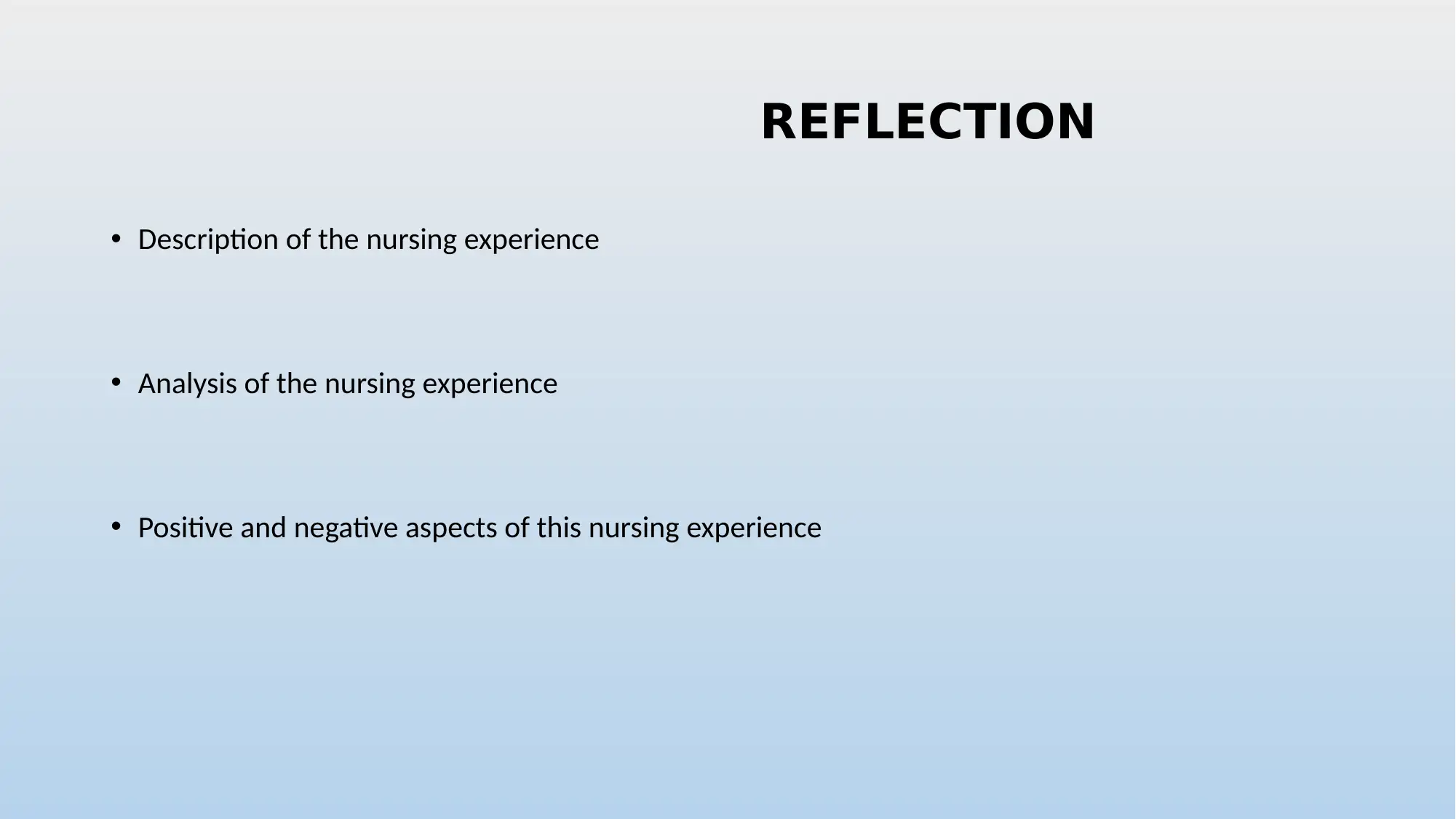
REFLECTION
• Description of the nursing experience
• Analysis of the nursing experience
• Positive and negative aspects of this nursing experience
• Description of the nursing experience
• Analysis of the nursing experience
• Positive and negative aspects of this nursing experience
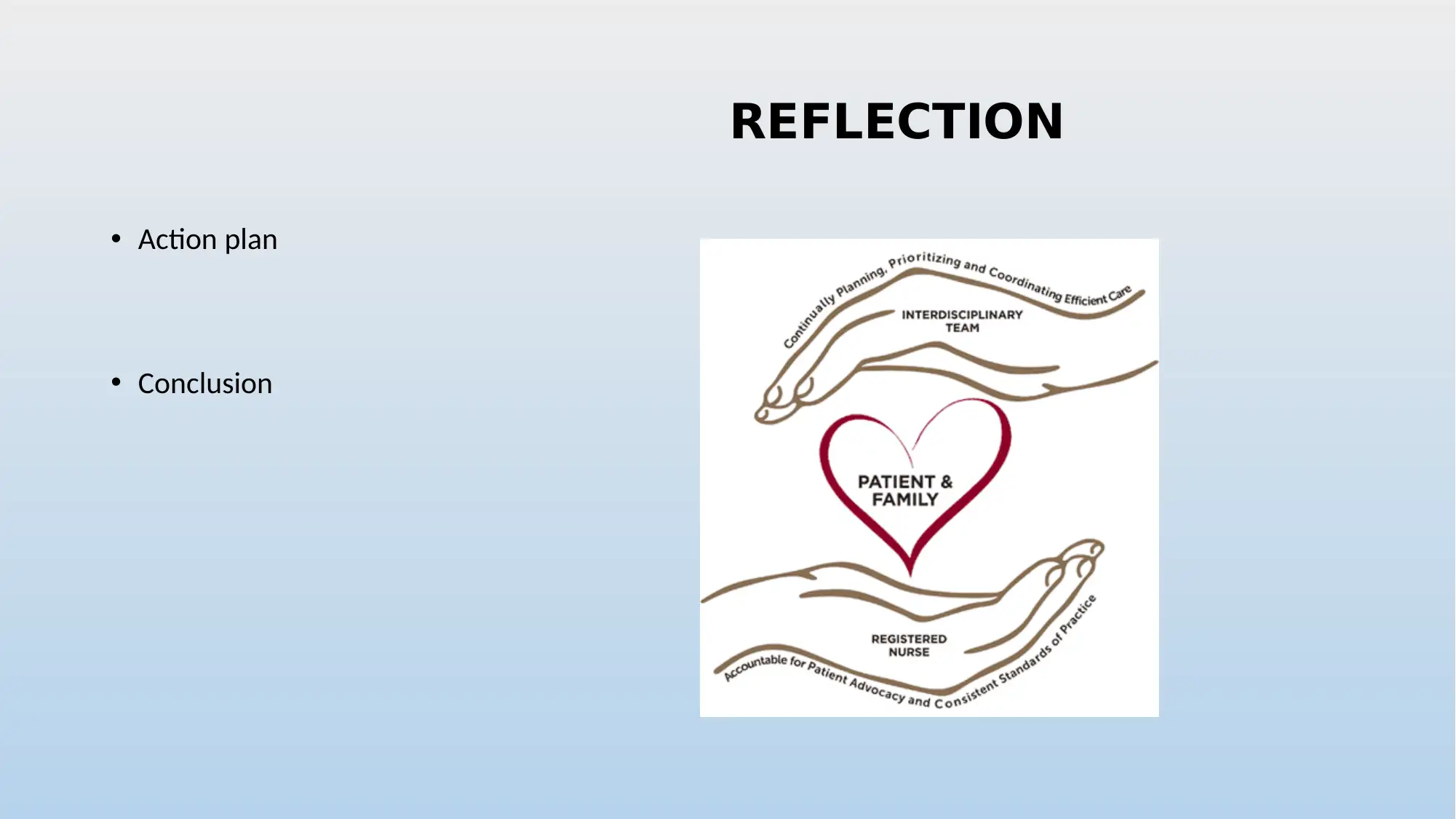
REFLECTION
• Action plan
• Conclusion
• Action plan
• Conclusion
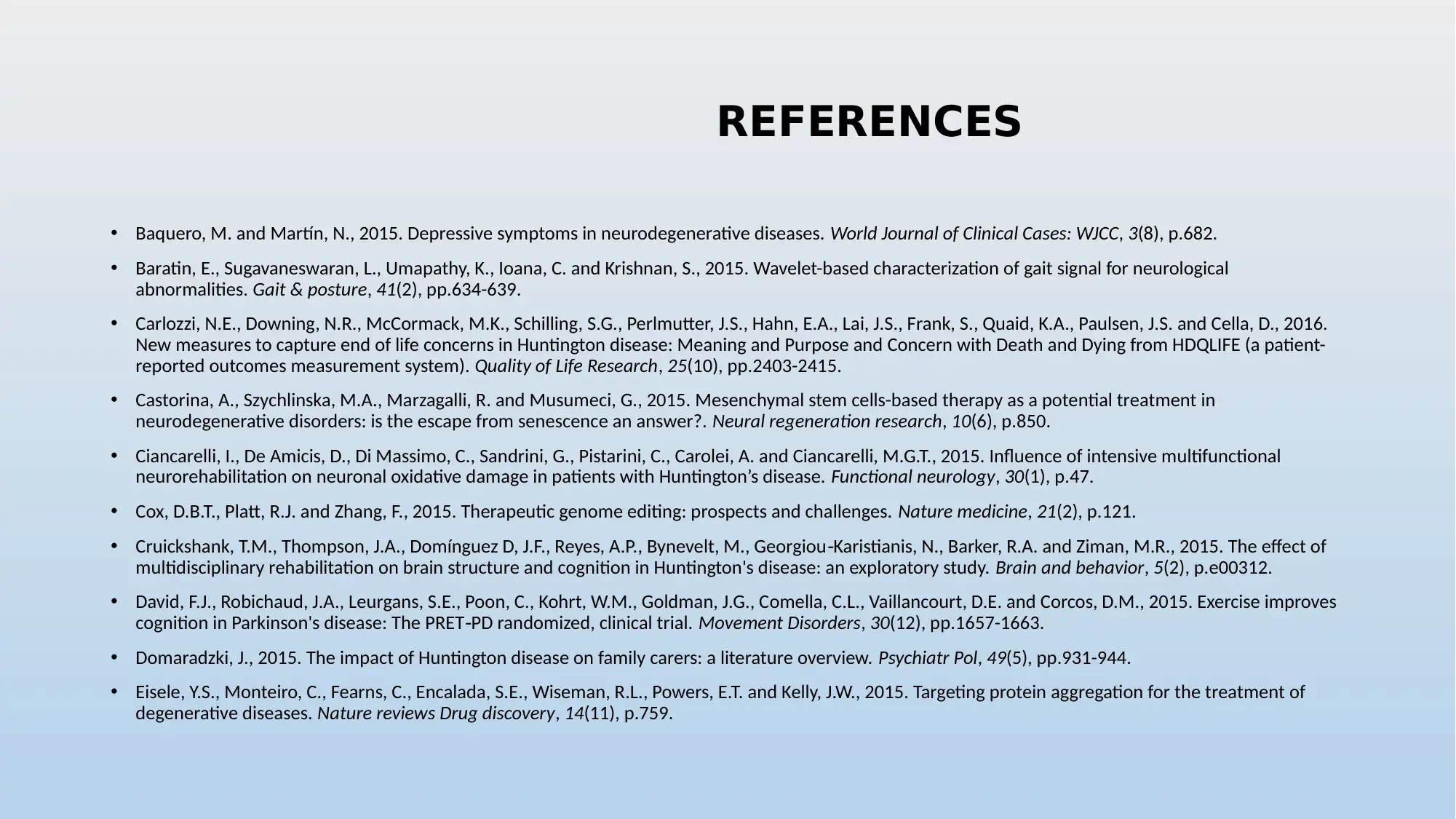
REFERENCES
• Baquero, M. and Martín, N., 2015. Depressive symptoms in neurodegenerative diseases. World Journal of Clinical Cases: WJCC, 3(8), p.682.
• Baratin, E., Sugavaneswaran, L., Umapathy, K., Ioana, C. and Krishnan, S., 2015. Wavelet-based characterization of gait signal for neurological
abnormalities. Gait & posture, 41(2), pp.634-639.
• Carlozzi, N.E., Downing, N.R., McCormack, M.K., Schilling, S.G., Perlmutter, J.S., Hahn, E.A., Lai, J.S., Frank, S., Quaid, K.A., Paulsen, J.S. and Cella, D., 2016.
New measures to capture end of life concerns in Huntington disease: Meaning and Purpose and Concern with Death and Dying from HDQLIFE (a patient-
reported outcomes measurement system). Quality of Life Research, 25(10), pp.2403-2415.
• Castorina, A., Szychlinska, M.A., Marzagalli, R. and Musumeci, G., 2015. Mesenchymal stem cells-based therapy as a potential treatment in
neurodegenerative disorders: is the escape from senescence an answer?. Neural regeneration research, 10(6), p.850.
• Ciancarelli, I., De Amicis, D., Di Massimo, C., Sandrini, G., Pistarini, C., Carolei, A. and Ciancarelli, M.G.T., 2015. Influence of intensive multifunctional
neurorehabilitation on neuronal oxidative damage in patients with Huntington’s disease. Functional neurology, 30(1), p.47.
• Cox, D.B.T., Platt, R.J. and Zhang, F., 2015. Therapeutic genome editing: prospects and challenges. Nature medicine, 21(2), p.121.
• Cruickshank, T.M., Thompson, J.A., Domínguez D, J.F., Reyes, A.P., Bynevelt, M., Georgiou Karistianis, N., Barker, R.A. and Ziman, M.R., 2015. The effect of‐
multidisciplinary rehabilitation on brain structure and cognition in Huntington's disease: an exploratory study. Brain and behavior, 5(2), p.e00312.
• David, F.J., Robichaud, J.A., Leurgans, S.E., Poon, C., Kohrt, W.M., Goldman, J.G., Comella, C.L., Vaillancourt, D.E. and Corcos, D.M., 2015. Exercise improves
cognition in Parkinson's disease: The PRET PD randomized, clinical trial.‐ Movement Disorders, 30(12), pp.1657-1663.
• Domaradzki, J., 2015. The impact of Huntington disease on family carers: a literature overview. Psychiatr Pol, 49(5), pp.931-944.
• Eisele, Y.S., Monteiro, C., Fearns, C., Encalada, S.E., Wiseman, R.L., Powers, E.T. and Kelly, J.W., 2015. Targeting protein aggregation for the treatment of
degenerative diseases. Nature reviews Drug discovery, 14(11), p.759.
• Baquero, M. and Martín, N., 2015. Depressive symptoms in neurodegenerative diseases. World Journal of Clinical Cases: WJCC, 3(8), p.682.
• Baratin, E., Sugavaneswaran, L., Umapathy, K., Ioana, C. and Krishnan, S., 2015. Wavelet-based characterization of gait signal for neurological
abnormalities. Gait & posture, 41(2), pp.634-639.
• Carlozzi, N.E., Downing, N.R., McCormack, M.K., Schilling, S.G., Perlmutter, J.S., Hahn, E.A., Lai, J.S., Frank, S., Quaid, K.A., Paulsen, J.S. and Cella, D., 2016.
New measures to capture end of life concerns in Huntington disease: Meaning and Purpose and Concern with Death and Dying from HDQLIFE (a patient-
reported outcomes measurement system). Quality of Life Research, 25(10), pp.2403-2415.
• Castorina, A., Szychlinska, M.A., Marzagalli, R. and Musumeci, G., 2015. Mesenchymal stem cells-based therapy as a potential treatment in
neurodegenerative disorders: is the escape from senescence an answer?. Neural regeneration research, 10(6), p.850.
• Ciancarelli, I., De Amicis, D., Di Massimo, C., Sandrini, G., Pistarini, C., Carolei, A. and Ciancarelli, M.G.T., 2015. Influence of intensive multifunctional
neurorehabilitation on neuronal oxidative damage in patients with Huntington’s disease. Functional neurology, 30(1), p.47.
• Cox, D.B.T., Platt, R.J. and Zhang, F., 2015. Therapeutic genome editing: prospects and challenges. Nature medicine, 21(2), p.121.
• Cruickshank, T.M., Thompson, J.A., Domínguez D, J.F., Reyes, A.P., Bynevelt, M., Georgiou Karistianis, N., Barker, R.A. and Ziman, M.R., 2015. The effect of‐
multidisciplinary rehabilitation on brain structure and cognition in Huntington's disease: an exploratory study. Brain and behavior, 5(2), p.e00312.
• David, F.J., Robichaud, J.A., Leurgans, S.E., Poon, C., Kohrt, W.M., Goldman, J.G., Comella, C.L., Vaillancourt, D.E. and Corcos, D.M., 2015. Exercise improves
cognition in Parkinson's disease: The PRET PD randomized, clinical trial.‐ Movement Disorders, 30(12), pp.1657-1663.
• Domaradzki, J., 2015. The impact of Huntington disease on family carers: a literature overview. Psychiatr Pol, 49(5), pp.931-944.
• Eisele, Y.S., Monteiro, C., Fearns, C., Encalada, S.E., Wiseman, R.L., Powers, E.T. and Kelly, J.W., 2015. Targeting protein aggregation for the treatment of
degenerative diseases. Nature reviews Drug discovery, 14(11), p.759.
Secure Best Marks with AI Grader
Need help grading? Try our AI Grader for instant feedback on your assignments.
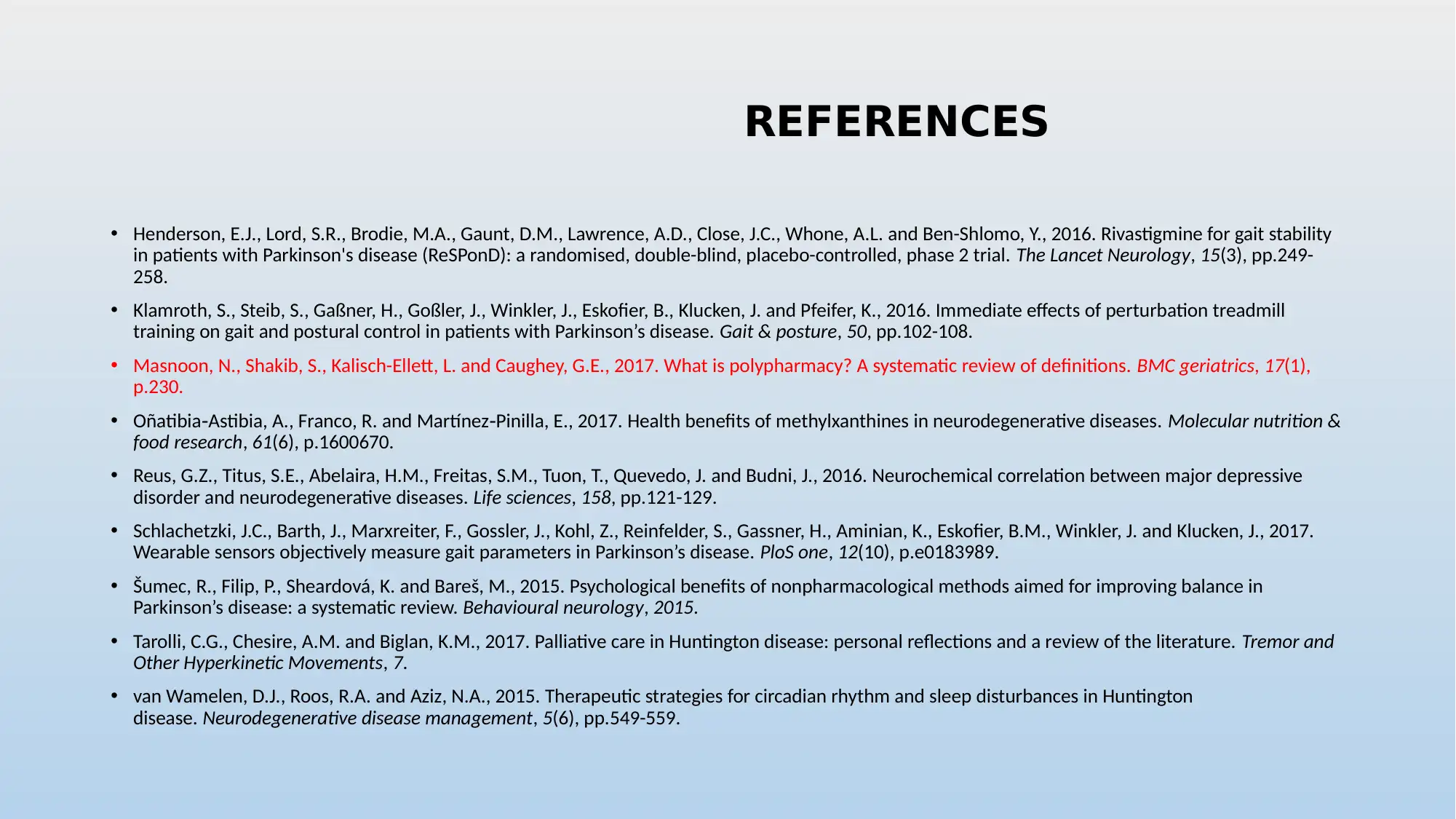
REFERENCES
• Henderson, E.J., Lord, S.R., Brodie, M.A., Gaunt, D.M., Lawrence, A.D., Close, J.C., Whone, A.L. and Ben-Shlomo, Y., 2016. Rivastigmine for gait stability
in patients with Parkinson's disease (ReSPonD): a randomised, double-blind, placebo-controlled, phase 2 trial. The Lancet Neurology, 15(3), pp.249-
258.
• Klamroth, S., Steib, S., Gaßner, H., Goßler, J., Winkler, J., Eskofier, B., Klucken, J. and Pfeifer, K., 2016. Immediate effects of perturbation treadmill
training on gait and postural control in patients with Parkinson’s disease. Gait & posture, 50, pp.102-108.
• Masnoon, N., Shakib, S., Kalisch-Ellett, L. and Caughey, G.E., 2017. What is polypharmacy? A systematic review of definitions. BMC geriatrics, 17(1),
p.230.
• Oñatibia Astibia, A., Franco, R. and Martínez Pinilla, E., 2017. Health benefits of methylxanthines in neurodegenerative diseases.‐ ‐ Molecular nutrition &
food research, 61(6), p.1600670.
• Reus, G.Z., Titus, S.E., Abelaira, H.M., Freitas, S.M., Tuon, T., Quevedo, J. and Budni, J., 2016. Neurochemical correlation between major depressive
disorder and neurodegenerative diseases. Life sciences, 158, pp.121-129.
• Schlachetzki, J.C., Barth, J., Marxreiter, F., Gossler, J., Kohl, Z., Reinfelder, S., Gassner, H., Aminian, K., Eskofier, B.M., Winkler, J. and Klucken, J., 2017.
Wearable sensors objectively measure gait parameters in Parkinson’s disease. PloS one, 12(10), p.e0183989.
• Šumec, R., Filip, P., Sheardová, K. and Bareš, M., 2015. Psychological benefits of nonpharmacological methods aimed for improving balance in
Parkinson’s disease: a systematic review. Behavioural neurology, 2015.
• Tarolli, C.G., Chesire, A.M. and Biglan, K.M., 2017. Palliative care in Huntington disease: personal reflections and a review of the literature. Tremor and
Other Hyperkinetic Movements, 7.
• van Wamelen, D.J., Roos, R.A. and Aziz, N.A., 2015. Therapeutic strategies for circadian rhythm and sleep disturbances in Huntington
disease. Neurodegenerative disease management, 5(6), pp.549-559.
• Henderson, E.J., Lord, S.R., Brodie, M.A., Gaunt, D.M., Lawrence, A.D., Close, J.C., Whone, A.L. and Ben-Shlomo, Y., 2016. Rivastigmine for gait stability
in patients with Parkinson's disease (ReSPonD): a randomised, double-blind, placebo-controlled, phase 2 trial. The Lancet Neurology, 15(3), pp.249-
258.
• Klamroth, S., Steib, S., Gaßner, H., Goßler, J., Winkler, J., Eskofier, B., Klucken, J. and Pfeifer, K., 2016. Immediate effects of perturbation treadmill
training on gait and postural control in patients with Parkinson’s disease. Gait & posture, 50, pp.102-108.
• Masnoon, N., Shakib, S., Kalisch-Ellett, L. and Caughey, G.E., 2017. What is polypharmacy? A systematic review of definitions. BMC geriatrics, 17(1),
p.230.
• Oñatibia Astibia, A., Franco, R. and Martínez Pinilla, E., 2017. Health benefits of methylxanthines in neurodegenerative diseases.‐ ‐ Molecular nutrition &
food research, 61(6), p.1600670.
• Reus, G.Z., Titus, S.E., Abelaira, H.M., Freitas, S.M., Tuon, T., Quevedo, J. and Budni, J., 2016. Neurochemical correlation between major depressive
disorder and neurodegenerative diseases. Life sciences, 158, pp.121-129.
• Schlachetzki, J.C., Barth, J., Marxreiter, F., Gossler, J., Kohl, Z., Reinfelder, S., Gassner, H., Aminian, K., Eskofier, B.M., Winkler, J. and Klucken, J., 2017.
Wearable sensors objectively measure gait parameters in Parkinson’s disease. PloS one, 12(10), p.e0183989.
• Šumec, R., Filip, P., Sheardová, K. and Bareš, M., 2015. Psychological benefits of nonpharmacological methods aimed for improving balance in
Parkinson’s disease: a systematic review. Behavioural neurology, 2015.
• Tarolli, C.G., Chesire, A.M. and Biglan, K.M., 2017. Palliative care in Huntington disease: personal reflections and a review of the literature. Tremor and
Other Hyperkinetic Movements, 7.
• van Wamelen, D.J., Roos, R.A. and Aziz, N.A., 2015. Therapeutic strategies for circadian rhythm and sleep disturbances in Huntington
disease. Neurodegenerative disease management, 5(6), pp.549-559.

THANK YOU
1 out of 12
Related Documents
Your All-in-One AI-Powered Toolkit for Academic Success.
+13062052269
info@desklib.com
Available 24*7 on WhatsApp / Email
![[object Object]](/_next/static/media/star-bottom.7253800d.svg)
Unlock your academic potential
© 2024 | Zucol Services PVT LTD | All rights reserved.




